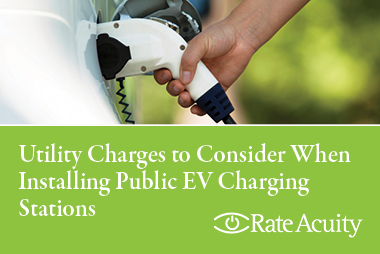One element to consider when locating public EV charging stations is that you should expect to pay plenty of charges. These charges come primarily from the utility that supplies the electricity. Since the profitability of your charging stations depends a great deal upon your costs, high on your due diligence list must be discovering all of the charges that an electric utility will require from you at each potential charging site.
Sometimes these charges are transparent and obvious. For example, if the electric utility that serves the location has a rate schedule for public EV charging, then discovering your costs is straightforward. But if the utility lacks such a rate schedule, then gleaning this information requires more work on your part. Here are the top four charges you should expect to pay.
1. Demand Charges
Demand charges rely on peak power usage rather than total energy consumption. These charges were originally intended to help electric utilities recover the expenses associated with supplying energy when their large customers (such as factories),exceeded specified energy thresholds.
Demand charges are based on the peak power demand of the EV charging station. They help account for the strain put on the electrical grid during periods of high charging demand, ensuring that the utility can meet the increased load requirements. When considering the suitability of a public EV charging site, discover if the utility will require you to pay more as demand increases.
Are there demand charges that will be billed, or is there a rate option without demand charges?
2. Rate Per kW for Demand Charges
Utilities typically structure their demand charges per kW consumed. This pricing structure ensures that customers pay for the actual electricity they use, encourages responsible energy consumption, and supports a reliable and sustainable electricity supply. If a particular location is going to require demand charges, you must discover how much they charge per kW for demand charges, and then calculate if that number fits your business model.
3. Time-of-Use Charges
Another item to consider is if the utility varies the cost of electricity based upon when it is used. In other words, do they adjust their kWh or kW rates based upon the time of day? Or do they charge different rates based upon the time of year? If so, how will this variability affect your estimated bottom line?
Time-of-use charges are typically higher during times of high electricity demand (from 7 AM to the mid to late evening, for example) and lower during hours of lower demand (such as overnight). Electricity prices fluctuate throughout the year due to varying levels of demand. Generally, electricity tends to be more affordable during the spring and fall seasons when the demand is lower. Conversely, during summer and winter, electricity market rates rise as people consume more electricity for cooling and heating purposes, such as air conditioning and heating systems.
4. Fixed Fees
Electric utilities impose fixed fees on owners of EV charging stations to cover various costs associated with providing services and maintaining the infrastructure. These fees are typically designed to ensure that the utility can recover its expenses, promote fair cost allocation, and encourage efficient use of the electrical grid. These fixed fees include:
- Connection fee: Covers the cost of connecting the EV charging station to the utility’s electrical grid, including installation and maintenance of the necessary infrastructure, such as meters, transformers, and distribution lines.
- Access or service fees: Electric utilities may impose access or service fees to cover administrative costs and customer support related to the operation of the EV charging station. These fees contribute to tasks like billing, meter reading, customer inquiries, and general service maintenance.
- Network fees: In some cases, utilities charge network fees to EV charging station owners, which contribute to the overall maintenance and expansion of the electrical grid infrastructure.
How high is the monthly fixed fee to have electric service at the charging station? Find out before investing in any location.
Conclusion
How do you determine where to optimally place EV stations? You consider your users (your primary source of revenue) and the electric utility (your primary source of costs). To uncover these costs, you need data—accurate and reliable data.
To help you make better informed decisions about charging station locations and ongoing costs, RateAcuity™ provides a comprehensive platform for accessing utility rate and tariff data. You compare costs across locations and utilities, and plan for the long term.
Contact us today to learn more about how RateAcuity™ helps your business succeed in the fast-growing EV market.
